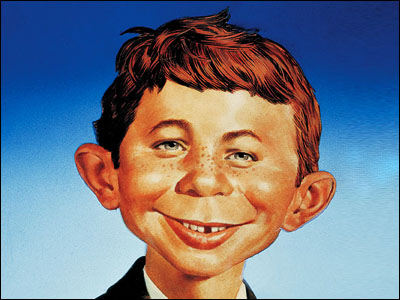
Mike Lynch has scans up on his site of a long, 1977 New York Times article on MAD Magazine. It's an odd piece. In 1977, MAD's founding editor, Harvey Kurtzman, had been gone for 22 of MAD's 25 years and yet the article is mostly about Kurtzman. His successors — editor Al Feldstein and assistant editors Nick Meglin and Jerry DeFuccio — are depicted in a photo but barely covered in the article. Publisher William M. Gaines gets mentioned only as necessary to speak of Kurtzman's contribution.
The authors note how MAD's readership has swelled to (at that point) a peak of over two million per issue but leave you with the impression that the swelling is indicative of Kurtzman's influence. Might not Feldstein, on whose watch most of those readers came aboard, have had a little something to do with that? The big color illustration depicts Spy Vs. Spy, the work of Don Martin and Paul Coker, and a movie parody drawn by Mort Drucker. Those are all aspects of MAD that came to be after Kurtzman departed. For that matter, the famous grinning countenance of Alfred E., though it had its origins in the Kurtzman years, is basically a calling card for the Feldstein era.
There are also a few historical points that conflict with my understanding. Mention is made of Kurtzman's merry, original band of artists — Will Elder, Jack Davis and Wally Wood — but the name of the fourth, John Severin, is omitted. The phrasing also suggests that Elder assisted Kurtzman with the layouts of all the early MAD stories. That's something I never heard before and do not believe is true.
The article says that Kurtzman decided to create MAD because he had jaundice and wanted a project he could do without leaving his room — again, not quite the way I heard it, not even from Kurtzman. Obviously, Harvey was interviewed for the piece and at that moment, chose to tell it that way. The way he told it to me and others was that his paycheck was lagging sadly behind that of Al Feldstein, who was writer-editor of other comics for the same company. The discrepancy was there because Feldstein was editing a book a week, whereas Kurtzman output one issue of his two war comics per month. And as an aside here: A topic for further discussion is to what extent this was because Harvey was a thorough perfectionist who researched every line down to microscopic degree, and to what extent Harvey was just one of those artists who did things right the first time, then did them over and over and over out of pure neurotic fear. Several who worked with Kurtzman, including Wally Wood, felt the latter was more often the case.
In any event, the way the story is more commonly told is that MAD was invented because Kurtzman needed to raise his income. Gaines used to claim that he suggested Harvey cobble up an additional comic — a humor title because it wouldn't require the research that the war comics did. Kurtzman said that was his own idea, and maybe it was. But the point is that the impetus to create MAD was that Kurtzman needed a project he could do in less time than he was spending on Two-Fisted Tales and Frontline Combat.
The tale of how MAD went from a dime color comic to a slicker black-and-white magazine is also at odds with accepted history. They say the switch was made to escape the Comics Code. Everyone, including Kurtzman, said it was because Kurtzman wanted out of the comic book format and was entertaining a job offer from a slick magazine. While he and Gaines did worry that censorship of some kind might lay ahead, the accepted history is that Gaines moved MAD to magazine format to keep Kurtzman from leaving. It appears to just have been fortuitous timing that the Comics Code was instigated the same month that MAD moved out of its jurisdiction.
I'm dwelling on a 33-year-old newspaper article to make a point here. I've been studying MAD since I was a tot and even wrote a book about that institution a few years ago. I've always heard about and even witnessed a certain friction between "The Kurtzman Kult," as some have dubbed it, and the folks who've done MAD since Harvey departed. I think both versions of the publication have vast amounts of merit and none of this is intended to debate the worth or even the relative worth of any era.
But I've heard Feldstein and others on his behalf complain about the tendency to praise Kurtzman by slighting those who came after and here's a perfect example. Harvey deserves mega-applause for his brilliance. The comic book issues of MAD may be the finest sprint of creativity ever in comics, and they're probably the funniest. But when he left, another era began under that logo…the era of Mort Drucker and Don Martin and Sergio Whatzisname and Frank Jacobs and a lot of brilliant writers and artists. That was the era of Feldstein, with Meglin adding funny and DeFuccio helping keep the machine operating…to say nothing of the talents of John Putnam, Leonard Brenner and others, including Bill Gaines. The N.Y. Times piece is, of course, largely forgotten…but the sentiments expressed are still present in so much that is written about the world's most popular humor magazine. There must be a way to give Kurtzman his due without minimizing those who followed.